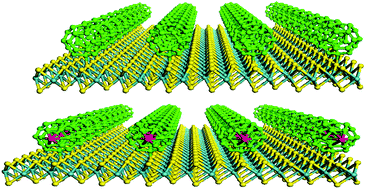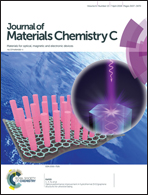Hybrid nanobud-array structures (C24)n/MoS2 and (C24V)n/MoS2: two-dimensional half metallic and ferromagnetic materials
Abstract
Two-dimensional (2D) hybrid nanobud-array structures, (C24)n/MoS2 and (C24V)n/MoS2, are designed by grafting (C24)n or (C24V)n fullerene arrays onto the surface of 2D monolayer MoS2 (ML-MoS2). Our density functional theory (DFT) computations show that the attachment of the (C24)n array onto the ML-MoS2 surface turns the 2D semiconductor (ML-MoS2) into a half metal, while the attachment of the (C24V)n array onto the ML-MoS2 surface turns the 2D semiconductor into a ferromagnetic (FM) metal. Our non-equilibrium Green's function (NEGF) computation indicates that the zigzag direction of the hybrid nanobud-array structures is more preferential for electron transport than the armchair direction. For the (C24)n/MoS2 system, the grafted (C24)n array not only can markedly increase the electron conductivity of ML-MoS2 but can also induce spin-polarized transport, that is, the spin-up state exhibits higher conductivity than the spin-down state. After placing a V atom between every two-neighboring C24 fullerenes along the zigzag direction, the conductivity is further enhanced. In contrast to (C24)n/MoS2, for (C24V)n/MoS2, the spin-down state exhibits higher conductivity than the spin-up state due to the strong contribution of the V 3d state to the spin-down state. The FM metal (C24V)n/MoS2 entails a magnetic moment of 2.3 μB per V atom. These results suggest that the 2D hybrid nanobud-array structures can be tailored as nanoelectronic parts with different electronic and transport properties by design.



 Please wait while we load your content...
Please wait while we load your content...